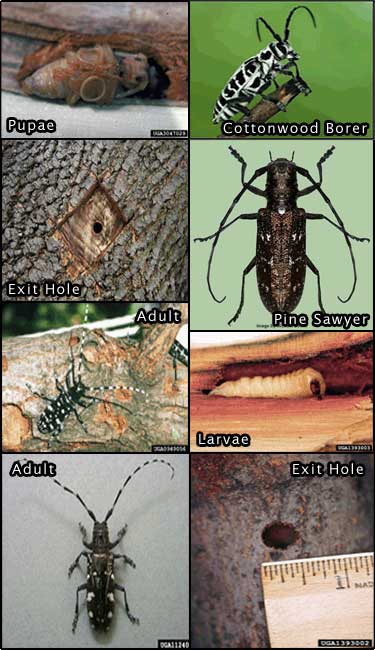Asian longhorned beetle
Anoplophora glabripennis
Description: Widely distributed in China, Japan, and Korea. First discovered attacking ornamental trees in Brooklyn, NY and Chicago, IL. They made their way to the US around 1996 in untreated wooden packing crates originating from China. Since being discovered, the beetle’s current distribution includes other areas of NYC, Illinois, Massachusetts, New Jersey and most recently, Ohio.
Identification: 0.75-1.5 in long. Males have antennae that are 1-2 times longer than their bodies. Females have antennae that are just about the size of their bodies. Adults are shiny “patent leather” black with irregular white spots. Has six legs, and antennae have alternating black and white bands. Feet and antennae appear to have a bluish tinge. Adults become active in early summer and remain until mid-fall.
Hosts: Acer (maple), Aesculus (horse chestnut), Albizia (mimosa), Betula (birch), Cercidiphyllum (katsura), Fraxinus (ash), Koelreuteria (golden rain tree), Platanus (sycamore), Populus (poplar), Salix (willow), Sorbus (mountain ash) and Ulmus (elm).
Life Cycle: Adults are usually active from May to October, with peak activity in midsummer. Females produce 30-70 eggs and larvae hatch inside of trees in 10-15 days. It only takes 1 year to go from egg to adult. Larvae can grow to be 2.4 inches long (60mm).
Impact and Damage: Adult females dig bowl-shaped holes in the bark, typically about 1/2 in (15 mm) in diameter, to bury their eggs in. Holes often appear orange in color. Sawdust/wood shavings may be apparent around the base of infested trees. Mature larvae enter the heartwood of trees, destroying the quality of the wood.
Similar species: The native Whitespotted Pine Sawyer (Monochamus scutellatus) (middle-right photo) is large and black but has less distinct white patches on the wing covers, no bluish coloring on the legs or antennae, and a distinctive white spot between the wing covers; they also do not damage healthy trees. Also, the native Cottonwood Borer (Plectrodera scalator) (top-right photo).
Monitoring and rapid response: Cut down infested trees, chip and burn all of the wood, and grind the stump.

Credits: The information provided in this factsheet was gathered from Beetlebusters.info, Columbia University and the Massachusetts Introduced Pests Outreach Project.
Individual species images that appear with a number in a black box are courtesy of the Bugwood.org network (http://www.invasive.org).Individual photo author credits may not be included due to the small display size of the images and subsequent difficulty of reading the provided text. All other images appear courtesy of Google (http://images.google.com).